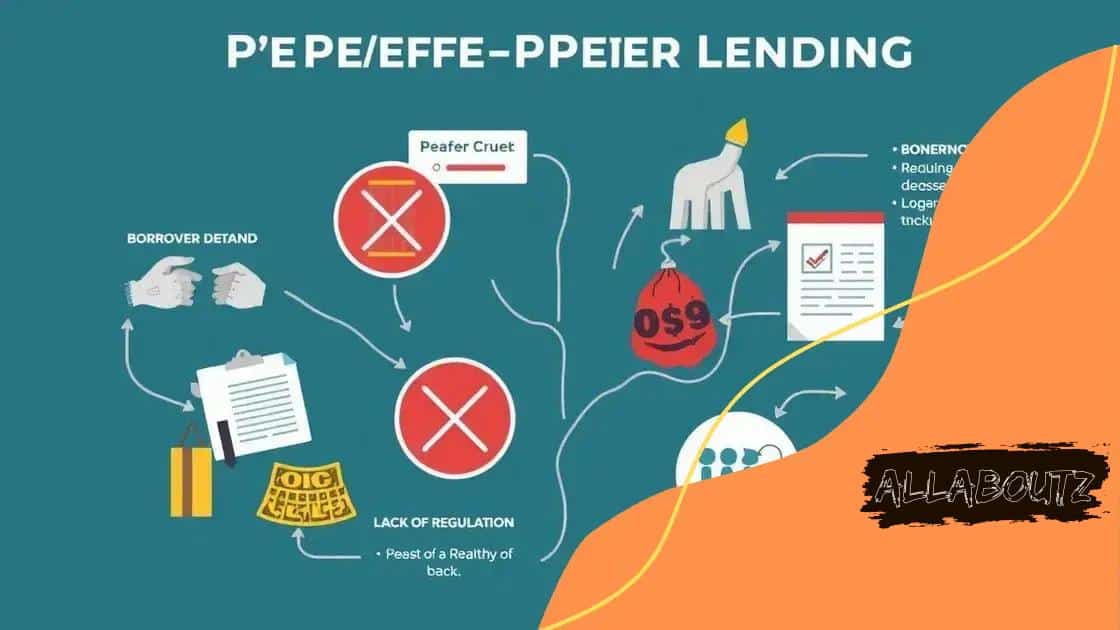Peer-to-peer lending platforms’ rise in popularity

Peer-to-peer lending platforms connect borrowers directly with lenders, offering lower interest rates and faster access to funds, but they also come with risks such as default and lack of regulation.
Peer-to-peer lending platforms’ rise in popularity is changing the way we think about borrowing and lending. Have you ever considered how these platforms might benefit you? Let’s dive into what makes them so appealing.
Understanding peer-to-peer lending
Understanding peer-to-peer lending is essential for anyone interested in the modern financial landscape. These platforms have gained significant traction by connecting borrowers with lenders directly, bypassing traditional banks. This approach not only simplifies the borrowing process but often results in better rates for both parties.
What is peer-to-peer lending?
Peer-to-peer lending involves individuals lending money to other individuals through online platforms. Rather than going through banks, borrowers post their funding needs, and lenders can review these requests. This method helps to create a community-driven financial system.
Benefits for borrowers
Borrowers can enjoy several advantages by opting for peer-to-peer lending. Some of these include:
- Lower interest rates compared to traditional banks.
- More flexible repayment terms.
- A quicker application process with less paperwork.
- Access to funding for those who might struggle to secure loans from conventional lenders.
As people look for better ways to manage their finances, peer-to-peer lending stands out as an attractive alternative. The convenience of online platforms makes it easier for borrowers to find loans tailored to their needs.
Benefits for lenders
Lenders also gain from this system. They have the opportunity to earn higher returns compared to traditional saving accounts or bonds. The risks are different, and lenders can diversify their investments by funding multiple loans at once, minimizing potential losses.
The growing popularity of peer-to-peer lending raises questions about reliability and trust. Many platforms use advanced algorithms to assess creditworthiness, making the lending process safer for all parties involved. As technology continues to evolve, we can expect the peer-to-peer lending landscape to expand even further, attracting more users seeking both financial support and investment opportunities.
Key advantages of peer-to-peer lending
The key advantages of peer-to-peer lending have made it a popular choice for both borrowers and investors. This innovative approach to lending offers a range of benefits that can significantly impact personal finances.
Lower Interest Rates
One of the most appealing aspects of peer-to-peer lending is the potential for lower interest rates. Traditional banks often impose high rates, whereas peer-to-peer platforms can offer better terms. This leads to cost savings for borrowers, allowing them to pay less over the life of the loan.
Quick and Convenient Process
The application process on peer-to-peer lending platforms is usually faster than traditional lenders. Borrowers can submit their requests online, reducing paperwork and waiting times. With the ease of submitting an application online, funds can often be disbursed quickly.
Accessibility for Various Credit Profiles
Many peer-to-peer platforms consider borrowers with a range of credit scores. This inclusivity means individuals who might struggle to secure loans from banks have a better opportunity to access funds. It’s an important advantage that helps meet diverse financial needs.
Another key advantage of peer-to-peer lending is the opportunity for lenders to earn higher returns on their investments. Unlike traditional savings accounts, which yield minimal interest, investing in loans through these platforms can offer much better returns. This appeals to those looking for alternative investment opportunities.
Additionally, both borrowers and lenders benefit from transparent terms. With clear information about rates, fees, and repayment schedules provided upfront, everyone involved can make informed decisions. The transparency fosters trust and confidence in the process, which is essential for a growing financial model.
Overall, the key advantages of peer-to-peer lending highlight its role as a disruptive force in finance. By connecting people directly, it can create better opportunities for those in need of funding while also benefiting those looking for alternative investment routes.
Risks involved in peer-to-peer lending

While peer-to-peer lending offers many advantages, it is important to understand the risks involved. Borrowers and lenders alike should be aware of the potential challenges before getting involved in this financial model.
Default Risk
One significant risk in peer-to-peer lending is the possibility of borrower default. This occurs when borrowers fail to repay their loans. If a borrower does not meet repayment terms, it can lead to losses for lenders. Platforms often assess the creditworthiness of borrowers, but there is still a chance that a borrower may default.
Lack of Regulation
Peer-to-peer lending operates in a less regulated environment compared to traditional banks. This lack of regulation can expose lenders to unethical practices. It is crucial for investors to conduct thorough research to avoid platforms that may not prioritize transparency.
Variable Returns
Returns on investments in peer-to-peer lending can be unpredictable. Factors such as economic fluctuations can influence the repayment capabilities of borrowers. While some loans may offer attractive interest rates, others may end in default, affecting overall returns.
Additionally, unlike traditional savings accounts, which have guaranteed returns, peer-to-peer investments can lead to inconsistent earnings. This unpredictability makes it essential for lenders to diversify their investments to mitigate risks.
Investors also face the risk of illiquidity, meaning that once money is lent, it may not be easily accessible until the borrower repays. This can pose challenges for those who may need immediate access to cash. Borrowers should also be cautious about taking on debt that may prove difficult to repay.
Before engaging in peer-to-peer lending, both borrowers and lenders should carefully evaluate the risks. Understanding these factors can help individuals make informed decisions, ensuring they are aware of the potential pitfalls associated with this lending model.
How to choose a peer-to-peer lending platform
Choosing the right peer-to-peer lending platform is crucial for both borrowers and lenders. With many options available, it can be overwhelming to make the best choice. Factors such as fees, interest rates, and platform reputation should be considered carefully.
Research the Platform
Start by researching various platforms. Look for those with a solid track record and positive reviews. Websites that provide comparisons can help you evaluate multiple options at once. Checking forums and online reviews can offer insight into user experiences.
Understand the Fees
Different peer-to-peer lending platforms have varying fee structures. Some may charge origination fees, while others may take a percentage of the loan amount. Be sure to read the fine print to avoid unexpected costs. Understanding these fees will help you calculate the total cost of borrowing or lending.
Assess Interest Rates
Compare interest rates across platforms. While some platforms may offer lower rates, others might provide better overall value when factoring in fees. Keep in mind that borrowers with better credit typically enjoy lower rates.
Look for Transparency
It is important to choose a platform that is transparent about its operations. Look for clearly outlined processes, terms, and conditions. A good platform will provide detailed information about how they assess risks and the criteria used for lending decisions.
Another vital consideration is customer support. A responsive customer service team can assist in addressing any concerns or questions you may have throughout the lending process. Ensure that the platform offers multiple ways to reach them, such as chat, email, or phone support.
Lastly, consider the platform’s features. Some platforms offer innovative tools for managing loans and tracking performance. Look for features that align with your specific needs, whether you’re borrowing or lending.
By taking these factors into account, you will be better equipped to choose a suitable peer-to-peer lending platform that meets your financial goals and preferences.
Future trends in peer-to-peer lending
The future of peer-to-peer lending looks promising as technology continues to evolve. With numerous innovations on the horizon, both borrowers and lenders can expect new opportunities and improvements in their experiences.
Increased Use of Technology
One trend is the increased use of advanced technology, such as artificial intelligence and machine learning. These tools help platforms assess credit risk more accurately. Enhanced algorithms will enable better matching of borrowers with lenders, creating a more efficient lending process.
Greater Transparency
As competition grows among peer-to-peer lending platforms, transparency will become more critical. Many platforms are already adopting clearer policies and user-friendly interfaces. This focus on transparency builds trust and helps users make informed decisions about their finances.
Expansion of Services
Another trend is the expansion of services offered on these platforms. Some companies are starting to provide additional products, like insurance or investment options. This diversification allows users to manage their finances in one place, making the process more convenient.
More regulatory clarity is also expected in the future, as governments around the world seek to manage the growing peer-to-peer lending market. This could lead to standardized practices that benefit users. Clear guidelines will help protect both borrowers and lenders, fostering a safer environment for financial interactions.
Additionally, peer-to-peer lending may expand globally, reaching underserved markets. This growth could provide access to loans for populations that typically face challenges in securing traditional bank loans. The potential for financial inclusion is significant, and platforms will likely focus on expanding their reach to include these markets.
Overall, the landscape of peer-to-peer lending is set to transform. With advancements in technology, transparency, and new services, both borrowers and lenders can anticipate a more dynamic and user-friendly environment in the future.
FAQ – Frequently Asked Questions about Peer-to-Peer Lending
What is peer-to-peer lending?
Peer-to-peer lending is a method where individuals lend money to other individuals through online platforms, bypassing traditional banks.
What are the main advantages of peer-to-peer lending?
The main advantages include lower interest rates, faster loan application processes, and greater access to funding for borrowers.
What risks are associated with peer-to-peer lending?
Risks include borrower default, lack of regulation, and variable returns for lenders.
How can I choose a reliable peer-to-peer lending platform?
You should research the platform’s reputation, understand their fee structures, and assess their transparency and customer support options.





